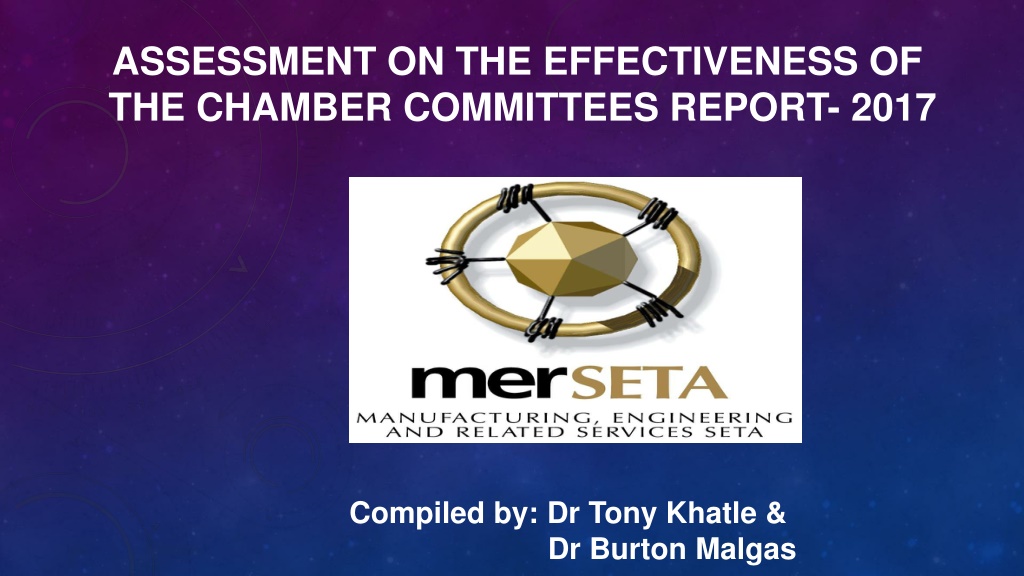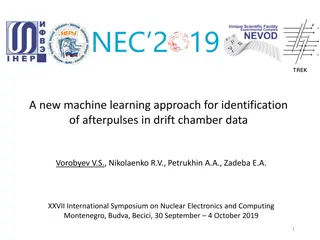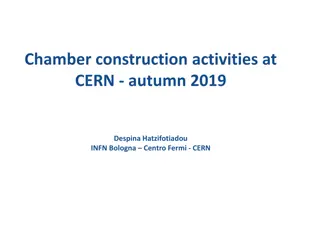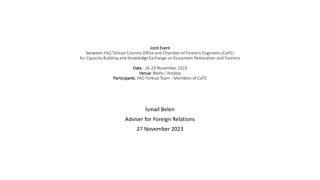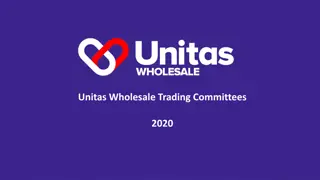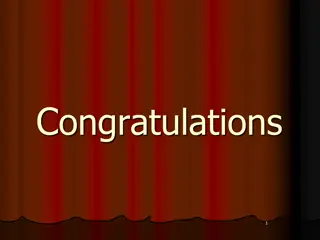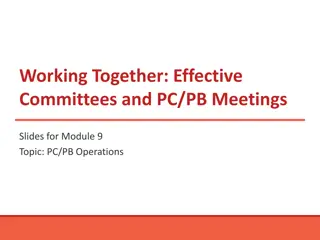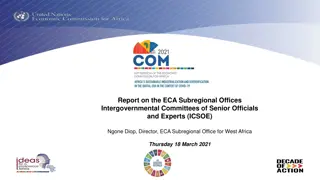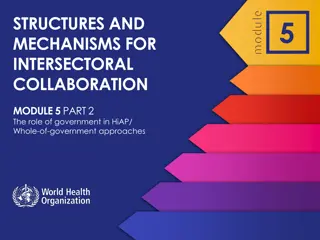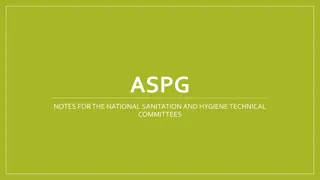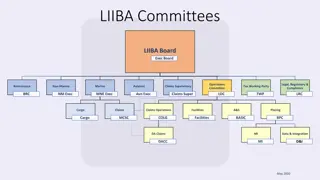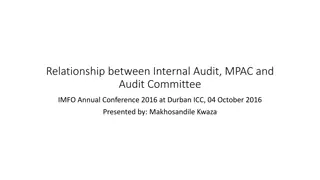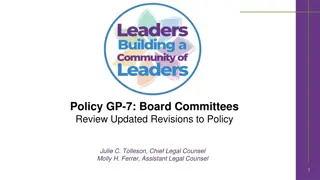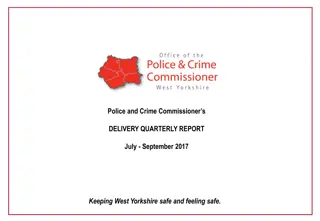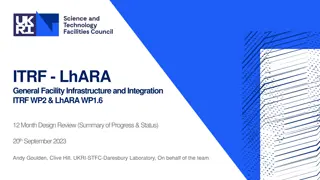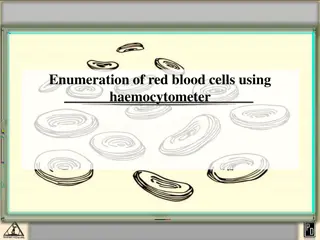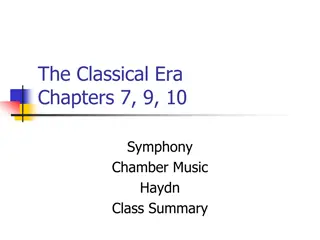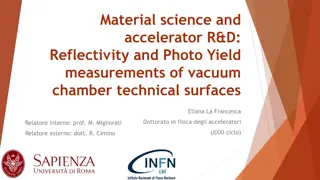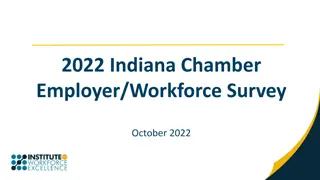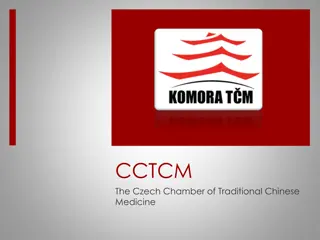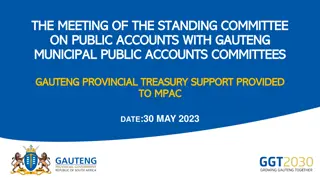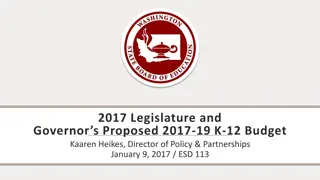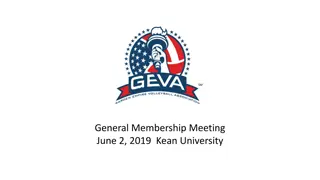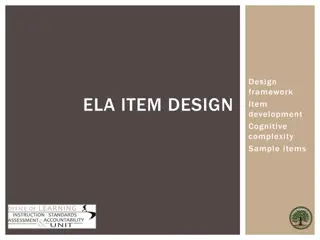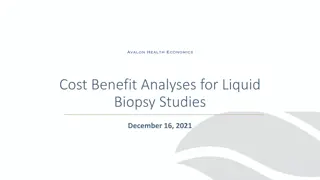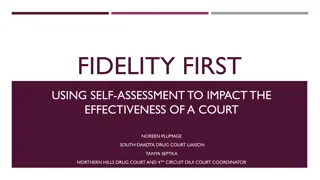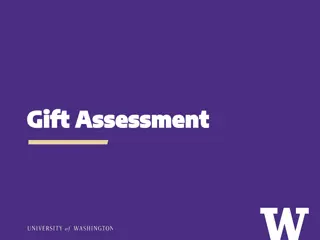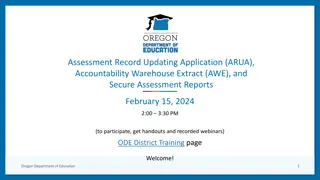Assessment of Chamber Committees' Effectiveness Report 2017
The assessment report focuses on evaluating the effectiveness of Chamber Committees in 2017 by investigating key areas, demographics, and performance of committee members. It includes details on research methodology, assessment dates, board evaluations, and the roles of committee members. Attendance data for different chamber committees is also provided, showing the presence percentage of members in meetings.
Download Presentation

Please find below an Image/Link to download the presentation.
The content on the website is provided AS IS for your information and personal use only. It may not be sold, licensed, or shared on other websites without obtaining consent from the author. Download presentation by click this link. If you encounter any issues during the download, it is possible that the publisher has removed the file from their server.
E N D
Presentation Transcript
ASSESSMENT ON THE EFFECTIVENESS OF THE CHAMBER COMMITTEES REPORT- 2017 Compiled by: Dr Tony Khatle & Dr Burton Malgas
MABATIMI MANAGEMENT SERVICES WELCOME
INTRODUCTION INTRODUCTION The research entailed a detailed investigation of the key and salient areas assigned to merSETA Chamber Committee members in the performance their roles and functions. The research further explored their demographics in order to establish their age, gender, race, experience and their educational background in an effort to understand their profile status. 3
INTRODUCTION To assist in assessing the effectiveness of the Chamber committees, the research was conducted on the following dates and areas provincially. Auto Chamber Committee (20) Durban on 24 Nov 2017 Metal Chamber Committee (20) Johannesburg on 25 October 2017 Motor Chamber Committee (20) Johannesburg on 7 Nov 2017 New Tyre Chamber Committee (20) Port Elizabeth on 17 Nov 2017 4 Plastic Chamber Committee (16) Cape Town 8 Nov 2017
BOARD EVALUATIONS Regular board evaluations helps ensure that board standards are maintained and the corporation is capable of ensuring long-term viability and credibility. This is true for both for-profit and not-for-profit Boards of directors. Board evaluations can assess the board s collective knowledge base, ability, and commitment to fulfilling their responsibilities. This includes a solid understanding of the responsibilities of the board of directors under all relevant legislation, the expectations of the Government, and the environment in which the corporation functions. 5
ROLE AND FUNCTIONS OF CHAMBER COMMITTEE MEMBERS A chamber committee member s basic role and function is to regularly attend meetings of the committee and work toward the fulfillment of the committee s objectives. Specific responsibilities include: Attend committee meetings Carry out individual assignments made by the committee chair Participate in committee discussions and decisions Review all material prior to meetings Attend appropriate chamber functions and events 6
CHAMBER COMMITTEE MEMBERS ATTENDANCE DATE CHAMBER TOTAL PRESENT ABSENT Ex-officio 30/10/2017 METAL 17 12=60% 8=40% 4 02/11/2017 MOTOR 21 12=57% 9=43% 5 08/11/2017 PLASTIC 17 11=65% 6=35% 3 17/11/2017 NEW TYRE 16 14=87,5% 2=12,5% 3 24/11/2017 AUTOMOBILE 21 16=76% 5=24% 4 7
CHAMBER COMMITTEE MEMBERS ATTENDANCE The attendance of chamber committee members is crucial for the effective functioning of a chamber. According to the above illustrated recorded attendance during the review; the New Tyre chamber recorded the highest attendance of 87, 5 %, followed Automobile chamber with 76%, thereafter Plastic chamber with 65% and Metal chamber with 60%, the least was Motor chamber with 57%. This implies average attendance of chamber committee members is 69.1% which can be considered as very good. This implies that there is room for improvement in the attendance of chamber committee members. 8
ANALYSIS OF CHAMBER QESTIONNAIRE The questionnaire was formulated to solicit and assess the performance of each merSETA chamber committee and its functionality in the fulfilment of merSETA overall objectives during its elected period. The main themes of the chamber evaluations are summed up as follows: Biographical details of members (Gender, Age, Race, Education levels) Experience (Years of experience, years in chamber) Sector Information (Representation of members, Size of the sector, provincial representation) 9
ANALYSIS OF CHAMBER QUESTIONNAIRE The Chamber impact assessment was categorised into the following sections for analysis: Research (sub sector input into sector skills plans) Policies (Making input into policies, recommendations and advice) Monitoring (Keeping up to date with developments, formulating annual work plans and ensuring coverage by agendas, providing appropriate and constructive input on matters for discussion and decision making Management of Committees (Identifying needs, secretariat performing of administrative functions), distribution of agendas, notice of meetings, ensuring meeting of chambers). 10
BIOGRAPHICAL INFORMATION: GENDER GENDER 12 10 10 9 9 8 8 7 6 6 4 4 3 3 2 2 0 Motor Retail Plastics Automobile New Tyre Metal Male Female The gender of chamber members comprises mainly males at 42 as compared to females, 18. This implies that there are more of males than females in the merSETA chamber committees. This is in line with the trend in the manufacturing sector. 11
BIOGRAPHICAL INFORMATION: AGE AGE GROUP 30 28 25 20 16 15 12 10 8 7 6 5 5 5 5 4 4 3 3 3 3 2 2 2 1 1 1 1 1 1 0 0 0 0 0 0 0 0 0 0 0 0 0 12 18-24 years 25-34 years 35-44 years 45-54 years 55-64 years 65+ Motor Retail Plastics Automobile New Tyre Metal Total
BIOGRAPHICAL INFORMATION: RACE RACE GROUPS 60 57 50 40 30 28 19 20 14 12 12 11 9 9 10 7 8 6 6 5 4 3 3 3 3 2 2 1 1 1 1 1 0 0 0 0 13 0 Motor Retail Plastics Automobile New Tyre Metal Total AFRICAN BLACK COLOURED INDIAN WHITE OTHER TOTAL
EDUCATION LEVELS NQF LEVELS 70 59 60 50 40 30 20 18 11 10 8 10 8 6 5 5 4 4 3 3 2 2 2 2 2 2 2 2 1 1 1 1 1 1 1 0 0 0 0 0 0 0 0 0 0 0 0 0 0 0 0 0 0 0 0 0 0 0 0 14 NQF 1 NQF 2 NQF 3 NQF 4 NQF 5 NQF 6 NQF 7 NQF 8 NQF 9 NQF 10 Total Motor Retail Plastics Automobile New Tyre Metal Total
YEARS OF EXPERIENCE YEARS OF EXPERIENCE 60 52 50 40 30 20 16 15 13 12 12 11 9 10 7 7 5 5 4 4 4 4 3 3 3 2 2 2 2 2 2 1 1 1 1 1 1 1 0 0 0 0 0 0 0 0 0 0 0 15 1-10 years 11-20 years 21-30 years 31-40 years 41-50 years 51-60 years Total Motor Retail Plastics Automobile New Tyre Metal Total
YEARS IN CHAMBER YEARS IN CHAMBER 30 25 25 20 16 15 10 9 9 8 7 5 5 5 4 3 4 4 3 3 2 2 2 2 1 0 2 2 1 1 1 1 1 1 0 0 0 16 1 2 3 4 4 or more Motor Retail Plastics Automobile New Tyre Metal Total
REPRESENTATION REPRESENTATION 140 120 100 64 80 Axis Title 60 41 40 16 20 13 13 11 11 22 11 6 10 7 7 7 3 5 4 3 0 Motor Retail Plastics Automobile New Tyre Metal Total Total 11 11 16 13 13 64 17 Labour representative 7 7 11 10 6 41 Employer representative 3 4 5 3 7 22 Other 1 0 0 0 0 1
SIZE OF THE SECTOR SIZE OF SECTOR 70 61 60 50 47 40 30 20 16 16 13 13 11 11 10 10 8 6 7 7 4 4 3 2 2 2 1 0 0 0 0 0 0 0 0 0 0 0 Micro enterprise (an informal sector business) Small enterprise (0 49 employees) Medium enterprise (50 149 employees) Large enterprise (150 + and more employees ) 18 Total Motor Retail Plastics Automobile New Tyre Metal Total
PROVINCIAL REPRESENTATION PROVINCIAL REPRESENTATION 70 60 58 50 40 35 30 20 16 11 11 10 10 10 10 10 9 7 5 5 6 3 3 3 2 2 3 1 1 1 2 1 1 1 2 1 1 0 0 0 0 0 0 0 0 0 0 0 0 0 0 0 0 0 0 0 0 0 0 1 0 0 0 0 0 0 0 19 0 Western Cape Gauteng KwaZulu-Natal Mpumalanga North West Limpopo Eastern Cape Northern Cape Free State Total Motor Retail Plastics Automobile New Tyre Metal Total
RESEARCH The research question mainly focussed on the Sector Skills Plan (SSP) and the chambers inputs into the SSP Most responses indicated that the input is outstanding, 53.4% of responses, and 19, 32.8% of responses indicated that it was good and 6, 10.3% were unsure. This indicates that most chamber members agree that they have performed well in the research area. It must be noted, however, that some members indicated that they would like to be developed and empowered through training in the area of research. 20
RESEARCH RESEARCH 35 31 30 25 20 Axis Title 19 15 10 8 7 7 6 5 5 6 4 4 5 3 3 1 1 1 1 1 1 1 2 0 0 0 0 0 0 0 0 1 0 1 Outstanding 2 Good 3 Not sure 4 Needs improvement 5 Poor Motor Retail 5 1 1 1 0 Plastics 6 4 1 0 0 Automobile 8 4 3 0 0 21 New Tyre 5 7 0 1 0 Metal 7 3 1 0 1 Total 31 19 6 2 1
POLICY The responses on policy indicates that most respondents have rated participation as outstanding with 103 which is 45,6%, followed by 78 which is 34,5% rated policy as good while 25 which is 11,1% were unsure. Only 19 which is 8, 4% rated policy as needing improvement. Only 1 which is 0, 4 % rated policy as poor. 22
POLICY POLICIES 120 103 100 80 78 60 40 31 25 22 25 19 17 20 16 16 19 15 13 10 7 7 6 5 4 3 3 3 2 1 1 0 0 0 0 1 0 23 1 Outstanding 2 Good 3 Not sure 4 Needs improvement 5 Poor Motor Retail Plastics Automobile New Tyre Metal Total
MONITORING The respondents mostly agreed that monitoring was outstanding; followed by good and unsure. A small number of respondents 29 believed that monitoring needs improvement and 19 responses believed that it was weak. There was 45, 1% representatives that agreed that monitoring was outstanding, 31, 7% believed that it was good and 10, 8% were unsure. There were 7, 5% that indicated that monitoring need improvement and 4, 9% indicated that it was poor. 24
MONITORING MONITORING 200 180 175 160 140 123 120 100 80 60 46 42 38 42 35 40 30 26 26 24 29 18 17 20 14 14 19 11 10 6 6 5 4 4 3 3 2 2 1 1 25 0 1 Outstanding 2 Good 3 Not sure 4 Needs improvement 5 Poor Motor Retail Plastics Automobile New Tyre Metal Total
MANAGEMENT OF COMMITTEES The management of the chamber committees assessment entails management of the composition, needs, chamber representation, management of alternates, vacancies, quorums, minutes amongst others. There were 756 responses that indicated that the management of the chambers was excellent on various areas (61,1%) and 275 responses indicated that it was good (22.2%) 136 responses was unsure (11%), while 41 responses indicated that it needs improvement and 30 responses 26 indicated that it was weak (2,4%).
MANAGEMENT OF COMMITTEES MANAGEMENT OF CHAMBERS 800 756 700 600 500 400 300 275 215 200 166 156 114 136 105 79 100 64 48 43 41 30 29 27 25 25 41 16 11 11 10 30 7 7 3 3 2 1 0 27 1 Outstanding 2 Good 3 Not sure 4 Needs improvement 5 Poor Motor Retail Plastics Automobile New Tyre Metal Total
CHALLENGES The chamber is run well but it is not proactively making an impact on critical issues The members require training on certain aspects related to their performance as members such as project management, research training as well as monitoring, amongst others. Although there is a good representation in age groups, youth are not well represented. The representation of micro and small organisations is a challenge and they play a vital role as constituent members of merSETA. There is a low representation of females in chambers. Although the chamber members have higher qualifications, more should be done to encourage further studies for members to improve effectiveness and efficiency of members There should be a more equitable representation of race groups according to demographics of the country. 28
RECOMMENDATIONS In order to accommodate all regions, (MerSETA Chamber Committees) might have to increase numbers to 20 people 10 labour 10 employer Involve chamber committee members in all led research and innovation projects Knowledge and experience in project management, knowledge and experience relevance to sector industry Relevant support and training for these members in research methods, so that they may be able to provide correct assistance in the research projects The sector should encourage youth to participate in the chambers for more representation of youth. More female representation on the chamber should be encouraged by the sector. The merSETA should encourage members of the chambers to further their studies through the offering of bursaries in fields where expertise is needed, this will not only enhance the capacity of merSETA but the sector as a whole. The merSETA should call for members which is in line with NSDS as well as the demographics of the country. 29
CONCLUSION The chamber assessment is an important task that allows the reflection and review of all the activities conducted during the year. It also gives merSETA the opportunity to re-evaluate the chambers functionality and to make recommendations to the Board based on the chamber self-evaluation assessment. It assists in the review whether individual member are meeting the requirements and whether they have sufficient capacity going forward. 30
THANK YOU 31
